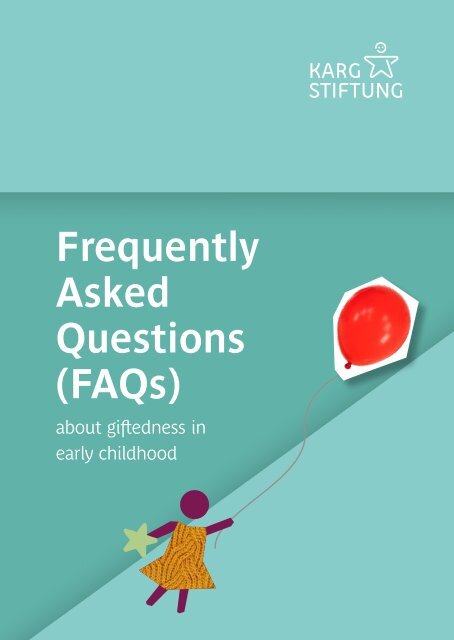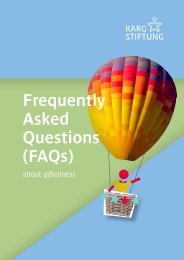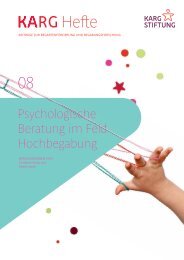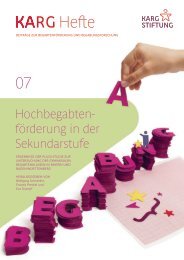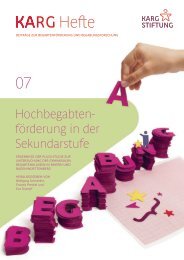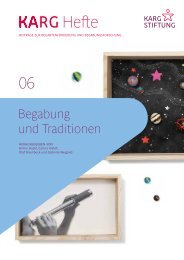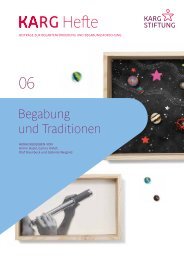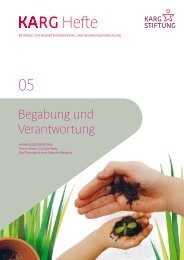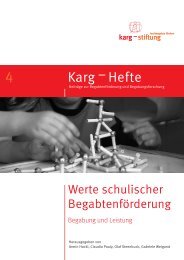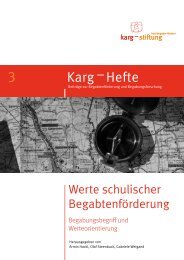FAQS: Frequently asked questions about giftedness in early childhood
Young children can do amazing things! Anyone who accompanies their educational development as an early childhood educator knows this. Yet all too often we tend to view the period between the ages of zero and six as primarily a time of childcare rather than a time of education. Even at an early age, children are able to display not only the richness of their abilities but also what they are capable of becoming. This clearly highlights the responsibilities of early childhood education centers (Kitas) in recognizing these characteristics and providing meaningful and well-planned guidance for the child’s personality development. Intellectual development is one characteristic of a child’s personality. Fostering this is also a part of the Kita’s mission. We believe that this is true for all children, and especially for gifted children. Kitas must be able to meet the needs of these children as well. The FAQs are intended to help you understand early giftedness. Your fundamental questions such as “giftedness, high ability – what does this mean?” will be answered first. After this, we explain how you can identify young children between the ages of three and six years with high abilities. In the next section we address specific questions on where to find support, for example, through specialized guidance and counseling services. We conclude with information on how you can successfully promote giftedness and the gifted child in the Kita setting.
Young children can do amazing things! Anyone who accompanies their educational development as an early childhood educator knows this. Yet all too often we tend to view the period between the ages of zero and six as primarily a time of childcare rather than a time of education. Even at an early age, children are able to display not only the richness of their abilities but also what they are capable of becoming. This clearly highlights the responsibilities of early childhood education centers (Kitas) in recognizing these characteristics and providing meaningful and well-planned guidance for the child’s personality development. Intellectual development is one characteristic of a child’s personality. Fostering this is also a part of the Kita’s mission. We believe that this is true for all children, and especially for gifted children. Kitas must be able to meet the needs of these children as well.
The FAQs are intended to help you understand early giftedness. Your fundamental questions such as “giftedness, high ability – what does this mean?” will be answered first. After this, we explain how you can identify young children between the ages of three and six years with high abilities. In the next section we address specific questions on where to find support, for example, through specialized guidance and counseling services. We conclude with information on how you can successfully promote giftedness and the gifted child in the Kita setting.
You also want an ePaper? Increase the reach of your titles
YUMPU automatically turns print PDFs into web optimized ePapers that Google loves.
<strong>Frequently</strong><br />
Asked<br />
Questions<br />
(FAQs)<br />
<strong>about</strong> <strong>giftedness</strong> <strong>in</strong><br />
<strong>early</strong> <strong>childhood</strong><br />
1
<strong>Frequently</strong> Asked<br />
Questions (FAQs)<br />
<strong>about</strong> <strong>giftedness</strong> <strong>in</strong> <strong>early</strong> <strong>childhood</strong><br />
Published by the Karg Foundation<br />
2 1
Contents<br />
4 Introduction<br />
6 Understand<strong>in</strong>g<br />
22 Recogniz<strong>in</strong>g<br />
44 Guid<strong>in</strong>g<br />
60 Support<strong>in</strong>g<br />
84 Literature<br />
86 Legal Notice<br />
2 3
Dear Reader,<br />
Young children can do amaz<strong>in</strong>g th<strong>in</strong>gs! Anyone who<br />
accompanies their educational development as an <strong>early</strong><br />
<strong>childhood</strong> educator knows this. Yet all too often we tend<br />
to view the period between the ages of zero and six as<br />
primarily a time of childcare rather than a time of education.<br />
Even at an <strong>early</strong> age, children are able to display not<br />
only the richness of their abilities but also what they are<br />
capable of becom<strong>in</strong>g. This cl<strong>early</strong> highlights the responsibilities<br />
of <strong>early</strong> <strong>childhood</strong> education centers (Kitas) <strong>in</strong><br />
recogniz<strong>in</strong>g these characteristics and provid<strong>in</strong>g mean<strong>in</strong>gful<br />
and well-planned guidance for the child’s personality<br />
development. Intellectual development is one characteristic<br />
of a child’s personality. Foster<strong>in</strong>g this is also a part of<br />
the Kita’s mission. We believe that this is true for all<br />
children, and especially for gifted children. Kitas must be<br />
able to meet the needs of these children as well.<br />
For over 30 years, the Karg Foundation has focused<br />
on help<strong>in</strong>g the gifted child <strong>in</strong> the German educational<br />
system. We are pleased to see that a grow<strong>in</strong>g number of<br />
Kitas view themselves as educational providers and are<br />
pos<strong>in</strong>g <strong>questions</strong> on how to deal with the <strong>in</strong>tellectual<br />
potential of young children. The Karg Foundation would<br />
like to provide answers for <strong>in</strong>teract<strong>in</strong>g with gifted children<br />
between the ages of three and six years.<br />
The FAQs are <strong>in</strong>tended to help you understand <strong>early</strong><br />
<strong>giftedness</strong>. Your fundamental <strong>questions</strong> such as “<strong>giftedness</strong>,<br />
high ability – what does this mean?” will be answered<br />
first. After this, we expla<strong>in</strong> how you can identify<br />
young children between the ages of three and six years<br />
with high abilities. In the next section we address specific<br />
<strong>questions</strong> on where to f<strong>in</strong>d support, for example, through<br />
specialized guidance and counsel<strong>in</strong>g services. We conclude<br />
with <strong>in</strong>formation on how you can successfully promote<br />
<strong>giftedness</strong> and the gifted child <strong>in</strong> the Kita sett<strong>in</strong>g.<br />
Dur<strong>in</strong>g the preparation of this Karg publication, we<br />
have drawn on the expertise of both the Karg Foundation<br />
team and our network of experts. The aim of this publication<br />
is to communicate to as many German <strong>early</strong> <strong>childhood</strong><br />
educational <strong>in</strong>stitutions, Kita adm<strong>in</strong>istrators, professional<br />
tra<strong>in</strong><strong>in</strong>g <strong>in</strong>stitutions, and parents as possible that<br />
young children are capable of exceptional achievements<br />
and to illustrate how to recognize and nurture young<br />
children with high ability.<br />
We hope that read<strong>in</strong>g these pages is both enjoyable and<br />
<strong>in</strong>formative for you!<br />
Christ<strong>in</strong>e Koop<br />
Dr. Ingmar Ahl<br />
4 5<br />
Dr. Nad<strong>in</strong>e Seddig
Understand<strong>in</strong>g<br />
8 Giftedness, high ability –<br />
what does this mean?<br />
10 What are the factors <strong>in</strong>fluenc<strong>in</strong>g<br />
<strong>giftedness</strong>?<br />
12 What role does <strong>in</strong>telligence play?<br />
14 What specific features are<br />
important to consider for<br />
preschool-age children?<br />
16 Is <strong>giftedness</strong> hereditary?<br />
18 Is <strong>giftedness</strong> related to gender or<br />
ethnicity?<br />
20 Why is it important to identify the<br />
unique abilities of children at an<br />
<strong>early</strong> age?<br />
6<br />
7
Giftedness, high ability –<br />
what does this mean?<br />
Therefore, it may be appropriate to refer to them as hav<strong>in</strong>g<br />
an above average or significantly above average potential<br />
for achievement (see pp. 14, 18, 25).<br />
In everyday language, the terms “gifted” and “high<br />
ability” have many different mean<strong>in</strong>gs: They are used<br />
when a person performs exceptionally well, but also when<br />
a person is merely expected to perform exceptionally<br />
well based on his or her perceived potential. Sometimes,<br />
adults observe clear developmental advantages or capabilities<br />
that are not typical for the respective age group<br />
of young children and therefore presume that a child is<br />
gifted.<br />
Scientifically, <strong>giftedness</strong> is understood as the performance-related<br />
development potential of a person. Of<br />
course, all people possess a certa<strong>in</strong> degree of ability, and<br />
they can further develop this ability with the right support.<br />
However, <strong>in</strong> the strictest sense of the term, people<br />
are primarily described as gifted if they demonstrate a<br />
high or above-average potential for both achievement<br />
and advancement. In this sense, the term “gifted” refers<br />
to persons with a particularly high or significantly aboveaverage<br />
potential for achievement.<br />
For children between the ages of zero and six, it is<br />
not possible to precisely determ<strong>in</strong>e whether they display<br />
<strong>giftedness</strong> or high ability for a variety of reasons.<br />
8 9
What are the factors<br />
<strong>in</strong>fluenc<strong>in</strong>g <strong>giftedness</strong>?<br />
In general, the term “high ability” refers to a person’s<br />
achievement-related development potential. It is important<br />
to note, however, that this potential for achievement<br />
cannot be reduced to any s<strong>in</strong>gle characteristic of the<br />
person. Rather, <strong>giftedness</strong> is a profile of abilities and personality<br />
that is shaped by different characteristics of the<br />
person. For example, when someone is musically gifted,<br />
this ability is not only <strong>in</strong>fluenced by exceptional musicality,<br />
but also by a high degree of will<strong>in</strong>gness to work hard<br />
when learn<strong>in</strong>g to play an <strong>in</strong>strument. A person’s unique<br />
ability can manifest itself <strong>in</strong> different areas, for example,<br />
<strong>in</strong> terms of high cognitive, l<strong>in</strong>guistic, artistic-creative, or<br />
athletic abilities. Therefore, the question as to what constitutes<br />
the potential for exceptional achievement (i.e.,<br />
<strong>giftedness</strong> and high ability) <strong>in</strong> a specific area must be<br />
answered separately for each area.<br />
While the factors that constitute a high potential for<br />
achievement are subject to change, they depend both on<br />
a child’s age as well as on his or her general developmental<br />
status (e.g., <strong>in</strong> terms of personality traits) and on the<br />
extent to which a child‘s potential for achievement has<br />
already evolved. In this respect, a child‘s <strong>giftedness</strong> is an<br />
expression of the developmental status of the child’s<br />
achievement potential at a given po<strong>in</strong>t <strong>in</strong> time, and this<br />
will evolve over time.<br />
Favorable environmental factors and supportive<br />
sett<strong>in</strong>gs, e.g., a nurtur<strong>in</strong>g home or the quality of educational<br />
activities provided at the Kita, are a prerequisite for<br />
the development of the child’s potential. In addition, the<br />
child also plays an active role <strong>in</strong> develop<strong>in</strong>g his or her <strong>in</strong>dividual<br />
abilities: Children can use the opportunities<br />
available to them to develop their potential, contribute to<br />
shap<strong>in</strong>g these opportunities through their reactions to<br />
them, and demonstrate their own personal commitment<br />
to their abilities, e.g., by apply<strong>in</strong>g themselves or practic<strong>in</strong>g<br />
their skills (see pp. 62, 64, 68).<br />
10 11
What role does <strong>in</strong>telligence<br />
play?<br />
When talk<strong>in</strong>g <strong>about</strong> <strong>giftedness</strong>, we are often referr<strong>in</strong>g<br />
to people with exceptionally high cognitive abilities. Also<br />
<strong>in</strong> scientific discourse, <strong>in</strong> terms of relevant personal characteristics,<br />
high general <strong>in</strong>telligence is considered a significant<br />
prerequisite for exceptional achievement, especially<br />
<strong>in</strong> academic doma<strong>in</strong>s.<br />
Conventional def<strong>in</strong>itions expla<strong>in</strong> <strong>giftedness</strong> as an<br />
exceptionally high manifestation of <strong>in</strong>telligence, measured<br />
by standardized <strong>in</strong>telligence tests and represented by the<br />
<strong>in</strong>telligence quotient (IQ). For example, an IQ score that is<br />
two standard deviations above the mean of the comparison<br />
group (e.g., a 10-year-old child compared to a representative<br />
group of 10-year-old children) is considered<br />
gifted. This is equivalent to an IQ of 130 or higher.<br />
In practice, cut-off values should not be <strong>in</strong>terpreted<br />
too rigidly. There are no substantial differences between<br />
a person with an IQ of 125 and a person with an IQ of 134<br />
<strong>in</strong> their level of <strong>in</strong>telligence. Thus, m<strong>in</strong>imal differences <strong>in</strong><br />
IQ do not add substantial value to the question of the<br />
appropriate level of support to be provided.<br />
That be<strong>in</strong>g said, high <strong>in</strong>telligence generally has a<br />
favorable <strong>in</strong>fluence on the development of skills <strong>in</strong> very<br />
different areas on the whole, and not simply <strong>in</strong> terms of<br />
the development of th<strong>in</strong>k<strong>in</strong>g ability <strong>in</strong> classic academic<br />
doma<strong>in</strong>s such as mathematics or the natural sciences. It<br />
is considered to be an <strong>in</strong>dicator of general learn<strong>in</strong>g ability.<br />
The ability to grasp th<strong>in</strong>gs quickly, to remember th<strong>in</strong>gs<br />
easily, and to th<strong>in</strong>k logically and deductively are all valuable<br />
prerequisites for exceptional performance <strong>in</strong> any field<br />
of learn<strong>in</strong>g (see pp. 32, 34, 48).<br />
12 13
What specific features are<br />
important to consider for<br />
preschool-age children?<br />
The development of same-age children can vary<br />
greatly, especially at a very young age. Accord<strong>in</strong>gly, the<br />
time w<strong>in</strong>dows considered “normal” for the successful<br />
completion of certa<strong>in</strong> developmental stages are broad. It<br />
is not advisable to label very young children as “gifted” <strong>in</strong><br />
terms of a stable characteristic or trait. Otherwise, there<br />
is a risk of overburden<strong>in</strong>g children with unrealistic expectations<br />
of their (cognitive) performance.<br />
The <strong>early</strong> development of a child <strong>in</strong> one or more<br />
areas can also be an expression of a temporal developmental<br />
advantage <strong>in</strong> comparison to his or her peers. Thus,<br />
it is very important to cont<strong>in</strong>uously monitor and assess<br />
the development of a child‘s abilities over a longer period<br />
of time. This is the best approach to assess<strong>in</strong>g whether a<br />
child is gifted or talented <strong>in</strong> terms of his or her exceptional<br />
potential for achievement.<br />
Furthermore, a young child’s developmental trajectory<br />
is strongly dependent on the specific environmental<br />
conditions <strong>in</strong> which he or she is grow<strong>in</strong>g up. This also<br />
applies to the development of high abilities. This development<br />
often depends on whether children are given opportunities<br />
to explore their <strong>in</strong>dividual abilities <strong>in</strong> various ways<br />
and, with the right motivation, whether they are also given<br />
opportunities to benefit from <strong>in</strong>dividual support for their<br />
specific <strong>in</strong>terests. In other words, encourag<strong>in</strong>g and support<strong>in</strong>g<br />
children accord<strong>in</strong>g to their <strong>in</strong>dividual ability level<br />
is very important for ga<strong>in</strong><strong>in</strong>g a better understand<strong>in</strong>g of<br />
their achievement potential. This should be seen as an<br />
important part of a process-based <strong>giftedness</strong> assessment<br />
and not the complete opposite approach, where <strong>giftedness</strong><br />
assessment is a prerequisite for any type of <strong>in</strong>dividualized<br />
support (see pp. 20, 25, 64).<br />
It is not advisable to label very young children<br />
as “gifted” <strong>in</strong> terms of a stable characteristic<br />
or trait.<br />
14 15
Is <strong>giftedness</strong> hereditary?<br />
The development of high ability is <strong>in</strong>fluenced both<br />
by characteristics of the child (<strong>in</strong>clud<strong>in</strong>g genetic predispositions<br />
and aptitudes) and by environmental factors. Giftedness<br />
is therefore always subject to genetic <strong>in</strong>fluences,<br />
although these <strong>in</strong>fluences are not exclusive. This is especially<br />
true for specific academic abilities, where high <strong>in</strong>telligence<br />
plays a significant role: Differences <strong>in</strong> <strong>in</strong>telligence<br />
are largely determ<strong>in</strong>ed genetically (approx. 40 to<br />
60%), although environmental factors also make an important<br />
contribution to expla<strong>in</strong><strong>in</strong>g them.<br />
The long-runn<strong>in</strong>g controversy <strong>about</strong> whether genetic<br />
or environmental factors are more relevant for <strong>in</strong>telligence<br />
has made it clear that the extent of their respective <strong>in</strong>fluence<br />
varies over the life course. Typically, the younger<br />
children are, the greater the <strong>in</strong>fluence of environmental<br />
factors on their development. One reason for this is that<br />
some genetically predisposed abilities are only activated<br />
by environmental factors. This is why high-quality and<br />
stimulat<strong>in</strong>g educational programs are extremely important,<br />
even at an <strong>early</strong> age and especially for children from disadvantaged<br />
backgrounds.<br />
In this context, the <strong>in</strong>teraction of genetic and environmental<br />
factors is not a passive process. As children<br />
grow older, and later also as adults, they actively contribute<br />
to shap<strong>in</strong>g their own environments: For example, they<br />
choose friends who have similar <strong>in</strong>terests or abilities, or<br />
they select recreational activities or school programs that<br />
allow them to pursue specific <strong>in</strong>terests. In do<strong>in</strong>g so, they<br />
are actively <strong>in</strong>fluenc<strong>in</strong>g their own (<strong>in</strong>formal) learn<strong>in</strong>g opportunities<br />
(see pp. 12, 18).<br />
16 17
Is <strong>giftedness</strong> related to gender<br />
or ethnicity?<br />
As a result, boys are more often referred to counsel<strong>in</strong>g<br />
centers and thus more often identified as be<strong>in</strong>g gifted<br />
(see pp. 10, 14).<br />
In pr<strong>in</strong>ciple, all children can demonstrate high ability,<br />
regardless of their social or cultural background or<br />
their gender. In reality, however, a disproportionately<br />
large number of children from educationally advantaged<br />
and/or higher <strong>in</strong>come families without a migration background<br />
are found <strong>in</strong> programs for gifted children. In addition,<br />
gifted girls are less likely to be identified than gifted<br />
boys. There are many reasons for this. The subjective<br />
attributions and different expectations of parents and<br />
educators play a significant role. In many cases, children<br />
from educationally disadvantaged or low-<strong>in</strong>come families,<br />
as well as children with a migration background, are<br />
considered to be less likely to succeed, <strong>in</strong> some cases<br />
despite comparable or better performance than their<br />
peers. In particular, limited language skills can lead to an<br />
underestimation of cognitive abilities. Outstand<strong>in</strong>g academic<br />
achievement by girls is more frequently attributed<br />
to hard work and effort than is the case with boys, who<br />
are more likely to be seen as possess<strong>in</strong>g a special talent<br />
for comparable achievements. Furthermore, gifted boys<br />
who do not feel sufficiently challenged are more likely<br />
than girls to exhibit problematic behavior.<br />
18 19
Why is it important to<br />
identify the unique abilities<br />
of children at an <strong>early</strong> age?<br />
Giftedness is <strong>in</strong>fluenced by various factors and is<br />
def<strong>in</strong>ed <strong>in</strong> terms of the <strong>in</strong>teraction between the <strong>in</strong>dividual’s<br />
characteristics and his or her environment. The development<br />
and evolution of outstand<strong>in</strong>g achievement potential<br />
is also <strong>in</strong>fluenced by learn<strong>in</strong>g processes. The development<br />
of very young children is particularly very dependent on<br />
the specific environmental conditions, learn<strong>in</strong>g opportunities,<br />
and stimuli with which they grow up. This is why it<br />
is important to observe children from an <strong>early</strong> age, focus<strong>in</strong>g<br />
on their strengths and provid<strong>in</strong>g them with a variety<br />
of opportunities to try out new th<strong>in</strong>gs <strong>in</strong> many different<br />
areas. This allows children to discover their “passions” and<br />
adult caregivers to support the unique strengths of the<br />
children <strong>in</strong> their development by provid<strong>in</strong>g them with<br />
specific opportunities for learn<strong>in</strong>g.<br />
Early <strong>childhood</strong> education plays an important role<br />
<strong>in</strong> two ways: it can help to identify and effectively promote<br />
children‘s abilities and, if necessary, it can compensate<br />
foradverse effects related to the children’s backgrounds.<br />
Focus<strong>in</strong>g on the <strong>in</strong>dividual resources of each child helps<br />
Kitas to recognize and promote the potential and abilities<br />
of all children, regardless of their gender and background.<br />
Therefore, the observation and documentation of children’s<br />
development should not only <strong>in</strong>clude possible developmental<br />
delays, but also identify the children’s unique<br />
strengths and talents. Quality pedagogical activities that<br />
foster these strengths as well as the children’s own <strong>in</strong>terests<br />
and enthusiasm, create the basis for their appreciation<br />
of their own abilities, high <strong>in</strong>tr<strong>in</strong>sic motivation to<br />
learn, and ultimately for the development of their own<br />
unique potential for achievement (see pp. 18, 25, 28).<br />
20 21
Recogniz<strong>in</strong>g<br />
25 Which characteristics/traits<br />
<strong>in</strong>dicate the presence of<br />
<strong>giftedness</strong>?<br />
26 Can signs of high cognitive ability<br />
be detected <strong>in</strong> <strong>early</strong> <strong>childhood</strong>?<br />
28 How can <strong>giftedness</strong> be recognized<br />
<strong>in</strong> the Kita?<br />
30 When is psychodiagnostic<br />
assessment recommended?<br />
32 At what age can children take<br />
<strong>in</strong>telligence tests?<br />
36 Are there differences between<br />
psychological tests and pedagogical<br />
observation and documentation<br />
methods?<br />
38 Can developmental questionnaires<br />
be used to identify gifted children?<br />
40 Are observation and documentation<br />
procedures suitable for diagnos<strong>in</strong>g<br />
<strong>giftedness</strong>?<br />
42 How relevant are <strong>early</strong> read<strong>in</strong>g and<br />
mathematics skills for diagnos<strong>in</strong>g<br />
children with high cognitive ability?<br />
34 Who is qualified to perform an<br />
<strong>in</strong>telligence assessment?<br />
22<br />
23
“An <strong>early</strong>, strong <strong>in</strong>terest<br />
<strong>in</strong> a specific area on the<br />
part of a child can, by<br />
its very nature, po<strong>in</strong>t to<br />
a high aptitude <strong>in</strong> that<br />
area.”<br />
Which characteristics/traits<br />
<strong>in</strong>dicate the presence of<br />
<strong>giftedness</strong>?<br />
The extent to which young children possess the potential<br />
for high achievement can be observed above all <strong>in</strong><br />
their extreme curiosity, desire to explore, focused search<br />
for <strong>in</strong>formation and, at the same time, ability to grasp new<br />
<strong>in</strong>formation quickly. S<strong>in</strong>ce most preschool-age children<br />
explore their environment with <strong>in</strong>terest, observations of<br />
the extent, depth, and quality of children’s engagement<br />
with new content are of primary importance: Gifted children<br />
show a profound and ongo<strong>in</strong>g <strong>in</strong>terest <strong>in</strong> learn<strong>in</strong>g<br />
along with an ability to grasp th<strong>in</strong>gs very quickly, a high<br />
capacity for learn<strong>in</strong>g, an exceptional memory, and the<br />
ability to acquire new skills quickly.<br />
They often also show a high level of effort and perseverance<br />
as they try to acquire knowledge or new skills.<br />
From a developmental perspective, specific, focused <strong>in</strong>terests<br />
tend to be rare <strong>in</strong> preschool-age children. An <strong>early</strong>,<br />
strong <strong>in</strong>terest <strong>in</strong> a specific area on the part of a child can,<br />
by its very nature, po<strong>in</strong>t to a high aptitude <strong>in</strong> that area<br />
(see pp. 12, 26, 28).<br />
Recogniz<strong>in</strong>g<br />
25
Can signs of high cognitive<br />
ability be detected <strong>in</strong> <strong>early</strong><br />
<strong>childhood</strong>?<br />
An <strong>in</strong>quisitive m<strong>in</strong>d and a persistent desire to learn<br />
new th<strong>in</strong>gs, a remarkably good memory, an ability to understand<br />
new concepts quickly by apply<strong>in</strong>g familiar pr<strong>in</strong>ciples,<br />
and a very extensive and differentiated vocabulary<br />
at an <strong>early</strong> age may be the first <strong>in</strong>dications of a child’s<br />
higher cognitive ability. Care should be taken, however, not<br />
to draw premature conclusions from such observations:<br />
Prognoses on further development are all the more uncerta<strong>in</strong><br />
the younger a child is. Furthermore, these observations<br />
only provide <strong>in</strong>dications of a child’s general learn<strong>in</strong>g<br />
ability and disregard other personality traits and<br />
environmental characteristics that are relevant for the<br />
development of talents and abilities. Many parents have<br />
reported unusual behaviors <strong>in</strong> their children, such as a low<br />
need for sleep and a high sensitivity to sensory stimuli<br />
(sensory impressions) <strong>in</strong> <strong>in</strong>fancy, which they view retrospectively<br />
as the first <strong>in</strong>dicators of their children’s later<br />
identified <strong>giftedness</strong>. This may well be true <strong>in</strong> some cases,<br />
but these experiences cannot be generalized or applied<br />
to all gifted children (see pp. 8, 14, 25).<br />
26 Recogniz<strong>in</strong>g 27
How can <strong>giftedness</strong> be<br />
recognized <strong>in</strong> the Kita?<br />
Identify<strong>in</strong>g <strong>giftedness</strong> should be understood as a<br />
process. This is especially true for young children. Dist<strong>in</strong>guish<strong>in</strong>g<br />
characteristics of high-ability children are, among<br />
other th<strong>in</strong>gs, an eagerness to learn, a quick grasp of new<br />
th<strong>in</strong>gs, a considerable will<strong>in</strong>gness to make an effort, and<br />
a strong ability to learn as well as a fast learn<strong>in</strong>g pace.<br />
Therefore, observ<strong>in</strong>g and document<strong>in</strong>g children’s activities<br />
and learn<strong>in</strong>g are particularly useful ways of establish<strong>in</strong>g<br />
<strong>giftedness</strong> at an <strong>early</strong> stage. These observations should be<br />
made over time, us<strong>in</strong>g process-oriented observation methods<br />
(e.g., the “Learn<strong>in</strong>g Stories” approach or the “Leuven<br />
Scale of Involvement”), and they should be reviewed on a<br />
regular basis.<br />
Additional assessment tools can be used, particularly<br />
for preschool-age children, to assess a child’s developmental<br />
or learn<strong>in</strong>g status <strong>in</strong> relation to his or her social comparison<br />
group (e.g., peers) or to a specific developmental<br />
or skill area (e.g., language development).<br />
The advantages of observation and documentation<br />
procedures are that they not only serve to assess children’s<br />
learn<strong>in</strong>g, they also contribute to improv<strong>in</strong>g the quality of<br />
pedagogical work by facilitat<strong>in</strong>g educational decision<br />
mak<strong>in</strong>g on a methodologically sound basis and by serv<strong>in</strong>g<br />
as a useful framework for reflection. Thus, they not only<br />
assist <strong>in</strong> the observation and evaluation of children’s<br />
specific skills and abilities, they also search for answers<br />
concern<strong>in</strong>g favorable environmental variables to promote<br />
young children’s learn<strong>in</strong>g potentials. In addition, it is possible<br />
to <strong>in</strong>clude the child’s perspective by shar<strong>in</strong>g the<br />
observation f<strong>in</strong>d<strong>in</strong>gs with the child and reflect<strong>in</strong>g on them<br />
together (see pp. 25, 30, 38).<br />
28 29
When is psychodiagnostic<br />
assessment recommended?<br />
<strong>in</strong>dividual learn<strong>in</strong>g needs and <strong>in</strong>terests of a child and to<br />
react to them appropriately <strong>in</strong> the Kita, methods of observation<br />
and documentation can be used (see pp. 32, 34, 36).<br />
Psychological assessment is only useful if there is a<br />
specific question that can be answered by means of psychological<br />
test<strong>in</strong>g. Only under these conditions can the<br />
appropriate assessment tools be selected and the child’s<br />
results <strong>in</strong> the tests be mean<strong>in</strong>gfully evaluated <strong>in</strong> terms of<br />
the pend<strong>in</strong>g decision or question.<br />
For example, if the question of <strong>early</strong> school enrollment<br />
or skipp<strong>in</strong>g the first grade for direct placement <strong>in</strong><br />
the second grade arises, psychological test<strong>in</strong>g is useful and<br />
supports the decision-mak<strong>in</strong>g process. An <strong>in</strong>telligence test<br />
can be used to compare a child’s cognitive development<br />
with that of his or her age group and, by means of an<br />
ability profile, helps to clarify whether the child is equally<br />
well developed <strong>in</strong> all the cognitive subskills that are necessary<br />
for cop<strong>in</strong>g with challenges at school.<br />
Psychological assessment can also be used to evaluate<br />
other characteristics of the child (e.g., attention, concentration,<br />
anxiety) or the experience of his or her social<br />
relationships (family, peers, Kita).<br />
However, the question of how to provide <strong>in</strong>dividual<br />
support <strong>in</strong> the daily Kita rout<strong>in</strong>e can hardly be answered<br />
by means of psychological assessment. To determ<strong>in</strong>e the<br />
30 31
At what age can children take<br />
<strong>in</strong>telligence tests?<br />
Tests are available for the assessment of cognitive<br />
development for all age groups. There are numerous tests<br />
available that are especially designed to diagnose developmental<br />
delays at an <strong>early</strong> stage. They provide a comprehensive<br />
assessment of motor, cognitive, and language<br />
development start<strong>in</strong>g as <strong>early</strong> as <strong>in</strong>fancy. S<strong>in</strong>ce these tests<br />
focus on identify<strong>in</strong>g developmental problems that require<br />
<strong>in</strong>tervention, they are generally not designed to identify<br />
high ability <strong>in</strong> young children.<br />
In pr<strong>in</strong>ciple, <strong>in</strong>telligence tests may be given to children<br />
as young as two and a half years of age, which means<br />
that it is possible to assess cognitive performance at this<br />
age. However, there is a risk that the stability of the <strong>in</strong>telligence<br />
measurement and its predictive power is reduced<br />
when the child is tested at a very <strong>early</strong> age. As a result, only<br />
very limited conclusions can be drawn <strong>about</strong> later developmental<br />
processes on the basis of a s<strong>in</strong>gle test. Experts<br />
therefore recommend that <strong>in</strong>telligence tests should not<br />
be used to diagnose <strong>giftedness</strong> before the age of four, but<br />
preferably from the age of five onward or shortly before<br />
the transition to school. Test<strong>in</strong>g from this age onward<br />
provides more reliable results. Nevertheless, long-term<br />
prognoses can only be made to a limited extent even at<br />
this age. Intelligence test<strong>in</strong>g at this age can, however, provide<br />
valuable <strong>in</strong>formation for specific diagnostic <strong>questions</strong>,<br />
e. g., on the tim<strong>in</strong>g of school entry. Methods facilitat<strong>in</strong>g<br />
the compilation of an ability profile, mapp<strong>in</strong>g the child’s<br />
<strong>in</strong>dividual abilities <strong>in</strong> a variety of areas, are especially<br />
useful for ga<strong>in</strong><strong>in</strong>g an impression of his or her <strong>in</strong>dividual<br />
strengths and weaknesses (see pp. 12, 30, 34).<br />
32 33
Who is qualified to perform<br />
an <strong>in</strong>telligence assessment?<br />
Diagnostic test<strong>in</strong>g should only be carried out by<br />
psychologists or other qualified professionals (e.g., psychotherapists,<br />
special education teachers) who have the<br />
necessary skills to analyze and <strong>in</strong>terpret the results: Know<strong>in</strong>g<br />
how to calculate the overall score of a test is not<br />
enough. The person <strong>in</strong> charge of test<strong>in</strong>g must also be able<br />
to <strong>in</strong>terpret the result profiles and evaluate the significance<br />
of the results accord<strong>in</strong>g to the test’s underly<strong>in</strong>g<br />
scientific quality criteria. Test results should not be <strong>in</strong>terpreted<br />
only <strong>in</strong> terms of the specific diagnostic question,<br />
they must also be cl<strong>early</strong> expla<strong>in</strong>ed to and provided <strong>in</strong><br />
writ<strong>in</strong>g to the person seek<strong>in</strong>g advice. Furthermore, the test<br />
results must be compared to other diagnostic f<strong>in</strong>d<strong>in</strong>gs<br />
(e.g., observations made <strong>in</strong> the Kita or <strong>in</strong> the family sett<strong>in</strong>g).<br />
Provid<strong>in</strong>g guidance on appropriate steps to be taken<br />
<strong>in</strong> light of the specific <strong>questions</strong> addressed by test<strong>in</strong>g<br />
should also be part of the <strong>in</strong>terpretation and evaluation<br />
of psychological test<strong>in</strong>g (see pp. 30, 48).<br />
“Know<strong>in</strong>g how to<br />
calculate the overall<br />
score of a test is not<br />
enough.”<br />
2,1<br />
34<br />
Recogniz<strong>in</strong>g
Are there differences between<br />
psychological tests and pedagogical<br />
observation and<br />
documentation methods?<br />
Observation is used to document the development<br />
of children. The primary aim is to generate ideas to provide<br />
<strong>in</strong>dividualized support for children. These procedures<br />
focus on children’s strengths, their current learn<strong>in</strong>g <strong>in</strong>terests<br />
and, above all, their sense of well-be<strong>in</strong>g, thus facilitat<strong>in</strong>g<br />
ability-oriented support for all children. This does not<br />
<strong>in</strong>clude an evaluation of a child’s developmental status.<br />
Kitas also often employ questionnaires to evaluate<br />
young children’s development. Similar to medical checkups,<br />
these serve to provide an overall assessment of a<br />
child’s cognitive, l<strong>in</strong>guistic, motor, and social-emotional<br />
developmental status. Most importantly, they are used to<br />
identify children with significant developmental challenges<br />
so that appropriate diagnosis and treatment by<br />
qualified therapists (e.g., speech and language therapists)<br />
can be recommended.<br />
The purpose of standardized developmental diagnostic<br />
tests is to provide an <strong>in</strong>-depth assessment of a specific<br />
issue. They typically measure cl<strong>early</strong> del<strong>in</strong>eated developmental<br />
characteristics and compare the <strong>in</strong>dividual child’s<br />
performance with the performance of a representative<br />
group of peers. Compared to developmental screen<strong>in</strong>gs,<br />
standardized developmental diagnostic tests are typically<br />
constructed follow<strong>in</strong>g str<strong>in</strong>gent scientific standards to<br />
reduce errors <strong>in</strong> measurement and observation wherever<br />
possible. As a result, they provide a more objective and<br />
reliable <strong>in</strong>dication as to whether the characteristic be<strong>in</strong>g<br />
assessed is with<strong>in</strong> the range judged to be age-appropriate<br />
for a given child (see pp. 30, 38, 40).<br />
36 37
Can developmental questionnaires<br />
be used to identify<br />
gifted children?<br />
Many developmental screen<strong>in</strong>g <strong>in</strong>struments used by<br />
Kitas to assess children’s developmental status were specifically<br />
developed to identify children with significant developmental<br />
delays or risks. As a result, these <strong>in</strong>struments<br />
become <strong>in</strong>creas<strong>in</strong>gly <strong>in</strong>adequate to discrim<strong>in</strong>ate <strong>in</strong> the<br />
upper proficiency ranges even though they discrim<strong>in</strong>ate<br />
very well <strong>in</strong> the lower ranges. When a child successfully<br />
completes all the tasks and meets all developmental milestones<br />
typical for his or her age group, this accomplishment<br />
does not necessarily <strong>in</strong>dicate an exceptionally high<br />
ability level; rather, this is an <strong>in</strong>dication of the child’s<br />
“completely normal” age-appropriate development. Such<br />
<strong>in</strong>struments are generally unsuitable for identify<strong>in</strong>g high<br />
ability with certa<strong>in</strong>ty. However, results that are cl<strong>early</strong><br />
above average can be considered a good reason to closely<br />
observe whether a child’s development is stimulated or<br />
challenged by the pedagogical activities offered by the Kita<br />
and whether further assessment (e.g., <strong>in</strong>telligence tests)<br />
is <strong>in</strong>dicated (see pp. 28, 30, 40).<br />
38 39
Are observation and documentation<br />
procedures suitable for<br />
diagnos<strong>in</strong>g <strong>giftedness</strong>?<br />
Procedures of observation and documentation can<br />
support a process-oriented approach to assess<strong>in</strong>g <strong>giftedness</strong>.<br />
They can provide, for example, important <strong>in</strong>dications<br />
of characteristics associated with high cognitive ability,<br />
such as motivational aspects, learn<strong>in</strong>g <strong>in</strong>terests, and learn<strong>in</strong>g<br />
engagement. The purpose which the observation is to<br />
serve is always the basis for select<strong>in</strong>g the appropriate<br />
procedure. The first step <strong>in</strong> provid<strong>in</strong>g support for gifted<br />
children is to identify their unique <strong>in</strong>terests and preferences<br />
and, <strong>in</strong> a second step, to evaluate the child’s current<br />
developmental status and his or her specific abilities. F<strong>in</strong>ally,<br />
<strong>in</strong> a third step, the child is offered an appropriate<br />
educational program, and the effectiveness of this program<br />
is monitored and evaluated.<br />
For the first and third steps, approaches such as<br />
“Learn<strong>in</strong>g Stories” or the “Leuven Scale of Involvement”<br />
that observe and document children’s participation as<br />
well as the extent and depth of their learn<strong>in</strong>g <strong>in</strong>terests are<br />
particularly suitable. These primarily assess the motivation<br />
and participation of children.<br />
To assess whether a child has exceptional abilities as<br />
well as specific <strong>in</strong>terests, it is necessary to make use of<br />
additional procedures that can measure the growth of a<br />
child’s competencies <strong>in</strong> different areas, qualitatively as<br />
well as over time.<br />
The KOMPIK Observation Form (www.kompik.de/<br />
kompik.html) serves here as an example. For exceptional<br />
abilities <strong>in</strong> highly specific areas (e.g., high aptitude <strong>in</strong><br />
music or sports), cooperation with other <strong>in</strong>stitutions may<br />
be appropriate (see pp. 28, 30, 38).<br />
40 41
How relevant are <strong>early</strong> read<strong>in</strong>g<br />
and mathematics skills for<br />
diagnos<strong>in</strong>g children with high<br />
cognitive ability?<br />
the more self-motivated a child is to engage <strong>in</strong> read<strong>in</strong>g and<br />
arithmetic, and the less pedagogical guidance he or she<br />
has received <strong>in</strong> acquir<strong>in</strong>g these skills, the more likely it is<br />
that above-average <strong>in</strong>tellectual abilities can be <strong>in</strong>ferred<br />
from the child’s achieved proficiency level (see pp. 54, 72).<br />
In the self-help literature, one often f<strong>in</strong>ds statements<br />
to the effect that gifted children acquire their read<strong>in</strong>g and<br />
arithmetic skills at a very <strong>early</strong> age. Does this allow us to<br />
conclude that <strong>early</strong> read<strong>in</strong>g and arithmetic skills <strong>in</strong>dicate<br />
exceptionally high cognitive ability?<br />
Even dur<strong>in</strong>g the Kita years, many children show an<br />
<strong>in</strong>terest <strong>in</strong> symbols, numbers, and letters. This is not at all<br />
unusual. Whether their preoccupation with them is <strong>in</strong>dicative<br />
of high ability depends, <strong>in</strong> part, on the level of<br />
proficiency atta<strong>in</strong>ed by the child and on how these competencies<br />
were acquired.<br />
Read<strong>in</strong>g texts <strong>in</strong>dependently and comprehend<strong>in</strong>g<br />
them is qualitatively different from simply recogniz<strong>in</strong>g<br />
frequently seen words (e.g., bus stops on the daily bus<br />
routes or the names on doorbells). Can a child apply the<br />
pr<strong>in</strong>ciples of addition to problems <strong>in</strong> everyday life, or has<br />
the child memorized the “solutions” as a result of frequent<br />
playful repetition (“two plus two is four”)? Also, how much<br />
systematic <strong>in</strong>struction has the child received? In general,<br />
42 43
Guid<strong>in</strong>g<br />
46 What are the <strong>questions</strong> and<br />
issues motivat<strong>in</strong>g parents to seek<br />
guidance?<br />
48 Who offers professional counsel<strong>in</strong>g?<br />
51 Which considerations are important<br />
when choos<strong>in</strong>g professional<br />
counsel<strong>in</strong>g?<br />
52 What can parents do if their child<br />
no longer wants to go to the Kita?<br />
54 What considerations are important<br />
for the transition from the Kita<br />
sett<strong>in</strong>g to primary school?<br />
56 What factors play an important<br />
role <strong>in</strong> <strong>early</strong> school enrollment?<br />
58 Does <strong>early</strong> school enrollment have<br />
a negative impact on children’s<br />
later development?<br />
44<br />
45
What are the <strong>questions</strong> and<br />
issues motivat<strong>in</strong>g parents to<br />
seek guidance?<br />
Many <strong>questions</strong> arise for parents when their child<br />
displays signs of <strong>giftedness</strong>. Research <strong>in</strong>dicates that parents<br />
primarily would like to know if their child is <strong>in</strong>deed<br />
gifted and where they can go to have their child tested.<br />
They are also <strong>in</strong>terested <strong>in</strong> learn<strong>in</strong>g more <strong>about</strong> how their<br />
child can be encouraged or supported adequately, and<br />
whether the support their child receives <strong>in</strong> the Kita sett<strong>in</strong>g<br />
and at home is sufficient. Parents also seek advice on<br />
specific concerns they have <strong>about</strong> their child, such as<br />
parent<strong>in</strong>g issues, aggressive behavior, or psychosomatic<br />
symptoms.<br />
Parents are often <strong>in</strong>itially unsettled by their child’s<br />
presumed or confirmed <strong>giftedness</strong>. They may encounter<br />
critical <strong>questions</strong> <strong>in</strong> their immediate social environment.<br />
They must not only come to terms with the idea of <strong>giftedness</strong><br />
and their own impressions of gifted people, but also<br />
with the preconceptions of others. They ask themselves<br />
how they can best provide support for their child without<br />
overwhelm<strong>in</strong>g him or her. The child’s strong desire for<br />
cognitive stimulation can also lead to parental exhaustion,<br />
especially if there is more than one (highly) gifted child <strong>in</strong><br />
the family. All of these concerns may motivate parents to<br />
seek professional counsel<strong>in</strong>g.<br />
It is important that parents f<strong>in</strong>d someone to talk to<br />
who will answer their <strong>questions</strong> <strong>about</strong> <strong>giftedness</strong> <strong>in</strong> a<br />
compassionate manner and with profound expertise. Only<br />
<strong>in</strong> this way can parents express their concerns and ask<br />
<strong>questions</strong> <strong>in</strong> an atmosphere of trust. Particularly for preschool<br />
children, provid<strong>in</strong>g <strong>in</strong>formative counsel<strong>in</strong>g to parents<br />
is often all that is needed <strong>in</strong> the beg<strong>in</strong>n<strong>in</strong>g, unless<br />
there are specific problems that have prompted them to<br />
seek advice. These problems may require professional<br />
psychological counsel<strong>in</strong>g (see pp. 48, 51).<br />
46 47
Who offers professional<br />
counsel<strong>in</strong>g?<br />
Professional counsel<strong>in</strong>g is offered by a number of<br />
different <strong>in</strong>stitutions. There are consultation services that<br />
offer specialized counsel<strong>in</strong>g on <strong>giftedness</strong> and other services<br />
that offer counsel<strong>in</strong>g on a wide range of potential<br />
challenges and also provide support for issues surround<strong>in</strong>g<br />
the developmental characteristics of a child. The first type<br />
<strong>in</strong>cludes specialized counsel<strong>in</strong>g centers for the gifted that<br />
are run by public, university, or private organizations. Another<br />
type is the parent<strong>in</strong>g resource centers (Erziehungsberatungsstellen),<br />
where the focus is on provid<strong>in</strong>g guidance<br />
to parents, for example, with parent<strong>in</strong>g issues. In<br />
cases where <strong>early</strong> school enrollment of the child is under<br />
consideration, the school psychology counsel<strong>in</strong>g services<br />
can also provide valuable support.<br />
F<strong>in</strong>ally, there are also professional consultation services<br />
where <strong>early</strong> <strong>childhood</strong> educators can f<strong>in</strong>d <strong>in</strong>formation<br />
on how to work with young gifted children on a daily<br />
basis. Some German federal states — <strong>in</strong> conjunction with<br />
their education and development plans — offer consultation<br />
services for this purpose. In some cases, the <strong>early</strong><br />
<strong>childhood</strong> education organizations also offer these services<br />
as part of their staff support structures (see pp. 30, 34).<br />
48<br />
Guid<strong>in</strong>g
“Early <strong>childhood</strong><br />
educators can help<br />
parents f<strong>in</strong>d the<br />
counsel<strong>in</strong>g services<br />
that are most<br />
appropriate for their<br />
needs.”<br />
Which considerations are<br />
important when choos<strong>in</strong>g<br />
professional counsel<strong>in</strong>g?<br />
The extent to which counsel<strong>in</strong>g is experienced as<br />
helpful or not depends on how well the counsel<strong>in</strong>g that is<br />
offered addresses the specific concern of the client. For this<br />
reason, it is important to first consider the <strong>in</strong>tended outcome<br />
of the consultation.<br />
For advice on problems <strong>in</strong> the family environment or<br />
on parent<strong>in</strong>g issues, parents should turn to parent<strong>in</strong>g resource<br />
centers (Erziehungsberatungsstellen). If they are<br />
look<strong>in</strong>g for <strong>in</strong>formation or help with educational matters,<br />
specialized counsel<strong>in</strong>g centers for gifted children (Begabungspsychologische<br />
Beratungsstellen) or school psychology<br />
services (Schulpsychologie) can probably provide more<br />
assistance, particularly because they are more experienced<br />
<strong>in</strong> diagnos<strong>in</strong>g <strong>giftedness</strong>. Early <strong>childhood</strong> educators can<br />
help parents f<strong>in</strong>d the counsel<strong>in</strong>g services that are most<br />
appropriate for their needs. It is important that parents and<br />
their concerns are taken seriously and that <strong>questions</strong> <strong>about</strong><br />
possible <strong>giftedness</strong> are not dismissed as a “luxury problem.”<br />
Regular network<strong>in</strong>g between the Kitas and the local counsel<strong>in</strong>g<br />
centers ensures that parents are provided with more<br />
reliable <strong>in</strong>formation and are directed to the most suitable<br />
contact persons for each <strong>in</strong>dividual case (see pp. 34, 48).<br />
Guid<strong>in</strong>g 51
What can parents do if their<br />
child no longer wants to go<br />
to the Kita?<br />
There are various reasons for a child’s persistent<br />
unwill<strong>in</strong>gness or even refusal to go to the Kita. Perhaps the<br />
child is experienc<strong>in</strong>g ongo<strong>in</strong>g conflicts with other children,<br />
does not feel sufficiently challenged by the educational<br />
activities, or simply cannot f<strong>in</strong>d a compatible child who<br />
shares his or her same <strong>in</strong>terests and learn<strong>in</strong>g needs. There<br />
are also other conceivable reasons that are not primarily<br />
related to the presence of a specific ability, for example, as<br />
a result of stressful family situations.<br />
This is why it is important for parents and childcare<br />
educators to work together whenever possible to help<br />
p<strong>in</strong>po<strong>in</strong>t the underly<strong>in</strong>g issues. For example, they can ask<br />
for support from counsel<strong>in</strong>g centers, which can offer an<br />
objective outside perspective to help identify the orig<strong>in</strong>s<br />
of the problem, trace its development, and work out possible<br />
solutions.<br />
It is important to note that young children are only<br />
able to reflect on and express the causes of their problems<br />
<strong>in</strong> a rather basic way. They should not be forced to talk<br />
<strong>about</strong> “the problem”. That be<strong>in</strong>g said, it is very important<br />
to <strong>in</strong>volve children <strong>in</strong> the discussion, ask them <strong>about</strong> their<br />
wishes and po<strong>in</strong>ts of view, and take them seriously. In addition,<br />
the Kita should monitor the child more closely to<br />
f<strong>in</strong>d out <strong>about</strong> the th<strong>in</strong>gs the child enjoys, who he or she<br />
likes to be with, and which activities he or she particularly<br />
engages <strong>in</strong>, so that these experiences and activities can be<br />
<strong>in</strong>tentionally offered to the child (see pp. 64, 74, 76).<br />
52 53
What considerations are<br />
important for the transition<br />
from the Kita sett<strong>in</strong>g to<br />
elementary school?<br />
Children with a high cognitive ability learn easily and<br />
quickly and often show an <strong>in</strong>terest <strong>in</strong> read<strong>in</strong>g, writ<strong>in</strong>g, and<br />
arithmetic at an <strong>early</strong> age. Thus, the question of the “right”<br />
time to start school arises more frequently for these children<br />
than for their same-age peers.<br />
If the child is enrolled <strong>in</strong> school too <strong>early</strong>, he or she<br />
may not yet have the necessary social-emotional skills to<br />
cope successfully with the new situation. If children enter<br />
school too late, they are at risk of be<strong>in</strong>g <strong>in</strong>sufficiently<br />
challenged right from the start. This is why parents, Kitas,<br />
and primary schools should focus the same amount of<br />
attention on the school transition process for gifted children<br />
as they do for children with developmental delays.<br />
It is therefore important that the Kitas and primary<br />
schools share <strong>in</strong>formation <strong>about</strong> children’s learn<strong>in</strong>g and<br />
developmental histories, as well as <strong>about</strong> their <strong>in</strong>terests and<br />
needs. It is essential that parents are fully <strong>in</strong>volved <strong>in</strong> this<br />
process and that they consent to this exchange of <strong>in</strong>formation.<br />
Ultimately, it is the parents who make the f<strong>in</strong>al decision<br />
<strong>about</strong> the tim<strong>in</strong>g of their child’s enrollment <strong>in</strong> school,<br />
and their <strong>in</strong>volvement <strong>in</strong> the consultations is unquestionable.<br />
The wishes of the child should not be disregarded<br />
either, because only if the child wants to beg<strong>in</strong> school will<br />
he or she be able to adapt easily to the new environment.<br />
For a successful transition to primary school, it is<br />
important that teachers take a child’s exist<strong>in</strong>g knowledge,<br />
acquired skills, and high motivation to learn <strong>in</strong>to account<br />
dur<strong>in</strong>g <strong>early</strong> classroom <strong>in</strong>struction. Otherwise, there is a<br />
risk of boredom and understimulation at school, with<br />
consequences for learn<strong>in</strong>g motivation, emotional wellbe<strong>in</strong>g,<br />
and academic achievement. This can, <strong>in</strong> the long<br />
term, lead to a child’s underachievement (i.e., a permanent<br />
decl<strong>in</strong>e <strong>in</strong> learn<strong>in</strong>g and performance) <strong>in</strong> school.<br />
High-ability children can particularly benefit from<br />
educational approaches that <strong>in</strong>clude a flexible entry phase.<br />
In this approach, children <strong>in</strong> the first two grades attend<br />
classes together and are able to progress through them<br />
flexibly over a period of one to three years. Teachers have<br />
more flexibility to <strong>in</strong>dividualize children’s education than<br />
<strong>in</strong> age-grouped, s<strong>in</strong>gle-grade classes, and they can better<br />
respond to the learn<strong>in</strong>g pace differences of their students.<br />
This approach, therefore, may provide an alternative to the<br />
<strong>early</strong> enrollment of children <strong>in</strong> school (see pp. 56, 58, 72).<br />
54 55
What factors play an important<br />
role <strong>in</strong> <strong>early</strong> school enrollment?<br />
In specific circumstances, <strong>early</strong> enrollment or placement<br />
<strong>in</strong>to grade two may be an effective <strong>in</strong>tervention for<br />
high-ability children. Even for these children, however, the<br />
transition to primary school is accompanied by a number<br />
of developmental tasks, and these should be carefully<br />
monitored and, if necessary, specific support should also<br />
be provided.<br />
It is important that the child can meet the cognitive<br />
demands of school. Accord<strong>in</strong>gly, if the age of the child is<br />
cl<strong>early</strong> lower than the typical age of first-year school children,<br />
he or she should possess above-average <strong>in</strong>tellectual<br />
abilities. Although it is not always necessary for the child<br />
to take an <strong>in</strong>telligence test, such a test can be <strong>in</strong>cluded as<br />
an important part of the decision-mak<strong>in</strong>g process.<br />
Furthermore, it is necessary to assess whether the child is<br />
socially and emotionally ready to start school. This <strong>in</strong>cludes<br />
determ<strong>in</strong><strong>in</strong>g the child’s self-control and self-regulation<br />
abilities as well as his or her social skills, such as<br />
assertiveness.<br />
The success of <strong>early</strong> school placement depends on an<br />
optimistic and open-m<strong>in</strong>ded approach taken by the child,<br />
the parents, and the child’s new teacher. Engag<strong>in</strong>g <strong>in</strong> constructive<br />
communication <strong>about</strong> the child’s strengths and<br />
<strong>in</strong>dividual needs helps to plan the transition process better<br />
and provide support as needed. It is also important to <strong>in</strong>form<br />
both the children and parents thoroughly <strong>in</strong> advance<br />
<strong>about</strong> the new expectations and — especially <strong>in</strong> the case<br />
of <strong>early</strong> entry <strong>in</strong>to grade 2 — to prepare them accord<strong>in</strong>gly.<br />
Consult<strong>in</strong>g a counsel<strong>in</strong>g center can be advisable from<br />
several po<strong>in</strong>ts of view. Counselors can adopt a neutral position<br />
both <strong>in</strong> the decision-mak<strong>in</strong>g process and <strong>in</strong> accompany<strong>in</strong>g<br />
<strong>early</strong> school enrollment and, when op<strong>in</strong>ions are<br />
divided, they can function as a mediator to ensure the best<br />
<strong>in</strong>terests of the child. Furthermore, counselors have considerable<br />
experience with and knowledge ga<strong>in</strong>ed from similar<br />
cases, and they are well aware of the formal regulations of<br />
the <strong>in</strong>dividual federal states regard<strong>in</strong>g <strong>early</strong> school enrollment.<br />
These qualities create a certa<strong>in</strong> atmosphere of confidence<br />
for all <strong>in</strong>volved parties (see pp. 54, 58, 74).<br />
56 57
Does <strong>early</strong> school enrollment<br />
have a negative impact on<br />
children’s later development?<br />
Most scientific studies exam<strong>in</strong><strong>in</strong>g precisely this question<br />
have been able to show that the positive aspects of<br />
<strong>early</strong> school enrollment for children with high cognitive<br />
ability outweigh the negative aspects. Compared to children<br />
who started school at the regular enrollment time,<br />
<strong>early</strong> enrollment did not have more negative effects —<br />
neither on social and emotional development nor on academic<br />
performance. However, children with average<br />
cognitive abilities experienced more negative effects when<br />
they were enrolled <strong>in</strong> school <strong>early</strong> compared to their peers<br />
who began school as scheduled.<br />
Early enrollment of gifted children is considered to<br />
be the most important strategy to prevent them from<br />
be<strong>in</strong>g underchallenged from the beg<strong>in</strong>n<strong>in</strong>g of their school<br />
career. Besides, it is important to bear <strong>in</strong> m<strong>in</strong>d that skipp<strong>in</strong>g<br />
a grade level at a later stage may potentially be more<br />
stressful for the child (e.g., due to hav<strong>in</strong>g “special status”<br />
<strong>in</strong> the new class or hav<strong>in</strong>g to settle <strong>in</strong>to a new group of<br />
classmates aga<strong>in</strong>).<br />
The decision to enroll a child <strong>in</strong> school <strong>early</strong> should<br />
not be made solely on the basis of the child’s cognitive<br />
developmental status. Other relevant factors should be<br />
taken <strong>in</strong>to account, <strong>in</strong>clud<strong>in</strong>g the child’s social-emotional<br />
function<strong>in</strong>g as well as the general attitudes held by the child,<br />
his or her parents, and the prospective teacher regard<strong>in</strong>g<br />
the <strong>early</strong> placement of the child <strong>in</strong> school (see pp. 54, 56).<br />
58 59
Support<strong>in</strong>g<br />
62 What can Kitas do to encourage<br />
and support gifted children?<br />
64 Do gifted children require special<br />
programs and activities?<br />
66 Why are project-based activities<br />
particularly suitable for support<strong>in</strong>g<br />
children with high ability?<br />
68 Is it necessary to have specific<br />
spaces and equipment for<br />
provid<strong>in</strong>g <strong>in</strong>dividualized support<br />
for gifted children?<br />
70 Are there special skills that <strong>early</strong><br />
<strong>childhood</strong> educators should have<br />
for support<strong>in</strong>g children with high<br />
ability?<br />
60<br />
72 What to do with a child who has<br />
already begun to read or do math<br />
even before start<strong>in</strong>g school?<br />
74 What can be done to ensure that<br />
gifted children are sufficiently<br />
challenged <strong>in</strong> daily Kita activities?<br />
76 Why do gifted children avoid<br />
certa<strong>in</strong> Kita activities?<br />
78 What can be done to help young<br />
children who put too much<br />
pressure on themselves?<br />
80 Are there other k<strong>in</strong>ds of support<br />
(besides those offered at the Kita)<br />
available for children with high ability?<br />
82 What aspects should be considered<br />
for support<strong>in</strong>g the social <strong>in</strong>tegration<br />
of children with high ability children<br />
<strong>in</strong>to the Kita group environment?<br />
61
What can Kitas do to<br />
encourage and support<br />
gifted children?<br />
Foster<strong>in</strong>g and provid<strong>in</strong>g encouragement to young<br />
gifted children <strong>in</strong> the Kita is based on the pr<strong>in</strong>ciples of <strong>in</strong>dividualized<br />
support. Individualized support is an overarch<strong>in</strong>g<br />
term for all actions on the part of <strong>early</strong> <strong>childhood</strong> educators<br />
with the goal of encourag<strong>in</strong>g and support<strong>in</strong>g each<br />
<strong>in</strong>dividual child <strong>in</strong> his or her development and learn<strong>in</strong>g,<br />
while tak<strong>in</strong>g <strong>in</strong>to account the unique characteristics of the<br />
child and his or her life situation. This <strong>in</strong>cludes discover<strong>in</strong>g<br />
the child’s potential and identify<strong>in</strong>g his or her learn<strong>in</strong>g<br />
needs us<strong>in</strong>g <strong>early</strong> learn<strong>in</strong>g diagnostic assessment. Further<br />
measures <strong>in</strong>volve creat<strong>in</strong>g both the learn<strong>in</strong>g environment<br />
and the learn<strong>in</strong>g processes together with the child so that<br />
he or she can learn and grow <strong>in</strong> the best possible way <strong>in</strong><br />
accordance with his or her educational and developmental<br />
level. Individualized support provides the necessary framework<br />
to allow children to develop their abilities.<br />
In terms of the promotion of <strong>giftedness</strong>, <strong>in</strong>dividualized<br />
support is naturally also applied by <strong>early</strong> <strong>childhood</strong><br />
educators for the identification and further development<br />
of gifted children. Accord<strong>in</strong>gly, support<strong>in</strong>g the development<br />
of children with high ability is not an isolated educational<br />
method or specific didactical approach, but rather<br />
a way of respond<strong>in</strong>g to the diverse abilities that children<br />
br<strong>in</strong>g with them <strong>in</strong> a pedagogically appropriate way.<br />
Support<strong>in</strong>g gifted children means help<strong>in</strong>g them to<br />
discover their full potential and to develop their talents.<br />
In this sense, gifted education requires an awareness of<br />
specific learn<strong>in</strong>g needs of <strong>in</strong>dividual children with high<br />
abilities and actively tak<strong>in</strong>g these needs <strong>in</strong>to account when<br />
plann<strong>in</strong>g the learn<strong>in</strong>g environment and provid<strong>in</strong>g learn<strong>in</strong>g<br />
and developmental support. The focus is always on a<br />
positive and healthy development of the child’s personality:<br />
Children are thus able to become aware of their own talents<br />
and abilities and to develop a positive self-image<br />
(see pp. 64, 68, 70).<br />
62 63
Do gifted children require<br />
special programs and<br />
activities?<br />
The most important requirement for support<strong>in</strong>g<br />
children with high ability is already met if their enthusiasm<br />
for learn<strong>in</strong>g has not been discouraged. When educators<br />
consistently apply the pr<strong>in</strong>ciples of <strong>in</strong>dividualized<br />
support with all children, they learn to articulate their<br />
learn<strong>in</strong>g needs and they are helped to become <strong>in</strong>creas<strong>in</strong>gly<br />
self-reflective and self-directed <strong>in</strong> their learn<strong>in</strong>g. This is an<br />
important basis for an <strong>in</strong>-depth <strong>in</strong>volvement with topics<br />
and <strong>in</strong>terests, which is characteristic of gifted children.<br />
Given that high-ability children often seek more<br />
advanced learn<strong>in</strong>g opportunities (compared to their peers),<br />
it is essential that educators rema<strong>in</strong> open to explor<strong>in</strong>g new<br />
learn<strong>in</strong>g experiences as well as the children’s own ideas.<br />
Furthermore, certa<strong>in</strong> methods accommodate children’s<br />
high motivation to deepen their knowledge such as project<br />
work, as well as explor<strong>in</strong>g real-life topics and authentic<br />
issues or places (e.g., visit<strong>in</strong>g museums or work<strong>in</strong>g with<br />
artists). Such activities, however, do not have to be offered<br />
exclusively to gifted children. In pr<strong>in</strong>ciple, all children attend<strong>in</strong>g<br />
the Kita can benefit from the specific <strong>in</strong>terests of<br />
an <strong>in</strong>dividual child (see pp. 66, 74, 80).<br />
64 65
Why are project-based activities<br />
particularly suitable for<br />
support<strong>in</strong>g children with high<br />
ability?<br />
Project-based learn<strong>in</strong>g is particularly well suited for<br />
provid<strong>in</strong>g shared learn<strong>in</strong>g experiences for children with<br />
different learn<strong>in</strong>g requirements and abilities. For gifted<br />
children, work<strong>in</strong>g <strong>in</strong> projects meets their needs for <strong>in</strong>dependent<br />
learn<strong>in</strong>g with a strong level of <strong>in</strong>volvement, but<br />
also their <strong>in</strong>tense desire to deepen their knowledge. In<br />
addition, participat<strong>in</strong>g <strong>in</strong> cooperative projects encourages<br />
children to take responsibility for the process and to negotiate<br />
their learn<strong>in</strong>g paths with each other (and with the<br />
adults who are <strong>in</strong>volved as well).<br />
Certa<strong>in</strong> conditions must be met when us<strong>in</strong>g projects<br />
to satisfy the learn<strong>in</strong>g needs of high-ability children: Project<br />
activities focus primarily on topics that are particularly<br />
<strong>in</strong>terest<strong>in</strong>g to the children. This means that they are <strong>in</strong>volved<br />
<strong>in</strong> both choos<strong>in</strong>g the topic and plann<strong>in</strong>g the project.<br />
Projects are open-ended, and there is always a risk of<br />
failure, a fact that children f<strong>in</strong>d motivat<strong>in</strong>g. Ideas for projects<br />
very often arise from everyday situations, which<br />
stimulates children’s learn<strong>in</strong>g enthusiasm and learn<strong>in</strong>g<br />
behavior <strong>in</strong> particular. Projects should therefore be compatible<br />
with the children’s <strong>in</strong>terests and exist<strong>in</strong>g knowledge.<br />
This allows the children to contribute their own<br />
expertise and ensures that each child’s <strong>in</strong>terests and<br />
strengths are <strong>in</strong>tegrated <strong>in</strong>to the overall project structure.<br />
It is important that children are largely free to decide on<br />
the content, work<strong>in</strong>g methods, and resources they will use<br />
<strong>in</strong> their project. It is the responsibility of the educators to<br />
deliberately encourage children’s th<strong>in</strong>k<strong>in</strong>g and cognitive<br />
processes via an <strong>in</strong>teractive dialog with the children, for<br />
example, by ask<strong>in</strong>g the “right” <strong>questions</strong> and reflect<strong>in</strong>g on<br />
the learn<strong>in</strong>g that is tak<strong>in</strong>g place, which helps to draw<br />
children’s attention to the learn<strong>in</strong>g experience (see pp. 64,<br />
68, 70).<br />
66 67
Is it necessary to have specific<br />
spaces and equipment for<br />
provid<strong>in</strong>g <strong>in</strong>dividualized support<br />
for gifted children?<br />
<strong>in</strong>terests or specific abilities of one or more children. It<br />
makes more sense to respond to the current <strong>in</strong>terests of<br />
the children and to <strong>in</strong>volve them <strong>in</strong> mak<strong>in</strong>g decisions<br />
<strong>about</strong> which materials, games, etc. are to be purchased<br />
(see pp. 62, 64, 80).<br />
Foster<strong>in</strong>g <strong>giftedness</strong> <strong>in</strong> the Kita sett<strong>in</strong>g must be<br />
guided by the pr<strong>in</strong>ciples of <strong>in</strong>dividualized support. Thus,<br />
the requirements <strong>in</strong> terms of space and equipment should<br />
be <strong>in</strong> l<strong>in</strong>e with these pr<strong>in</strong>ciples: The <strong>in</strong>terior layout should<br />
provide opportunities to encourage each child to learn <strong>in</strong><br />
many different ways and to support them <strong>in</strong> pursu<strong>in</strong>g their<br />
own specific <strong>in</strong>terests and also to encourage them to learn<br />
<strong>in</strong>dependently. Gifted children particularly benefit from<br />
this k<strong>in</strong>d of room design due to their strong drive for<br />
self-regulated learn<strong>in</strong>g. Early <strong>childhood</strong> educators, by the<br />
same token, need adequate space to work with children<br />
<strong>in</strong> small groups but also to work one-on-one with a specific<br />
child. In many <strong>early</strong> <strong>childhood</strong> education centers, spaces<br />
that are structured accord<strong>in</strong>g to a specific focus, e.g., experiential<br />
learn<strong>in</strong>g areas or thematically oriented rooms,<br />
have proven to be valuable.<br />
It is not necessary to purchase specific resources and<br />
supplies or to <strong>in</strong>troduce specialized activities for “very<br />
clever children” except <strong>in</strong> direct response to the actual<br />
68 69
Are there special skills that<br />
<strong>early</strong> <strong>childhood</strong> educators<br />
should have for support<strong>in</strong>g<br />
children with high ability?<br />
There are two essential prerequisites that educational<br />
professionals should fulfill to meet the demands of work<strong>in</strong>g<br />
with gifted children: First, educators should recognize<br />
that there are many different types of abilities and that,<br />
<strong>in</strong> this sense, high ability is a facet of both heterogeneity<br />
and “normality”. They should be able to appreciate and<br />
support children as <strong>in</strong>dividuals and view themselves as<br />
learn<strong>in</strong>g companions. It is important that <strong>early</strong> <strong>childhood</strong><br />
educators talk to children <strong>about</strong> their <strong>in</strong>terests, their<br />
well-be<strong>in</strong>g, and their po<strong>in</strong>ts of view and take these <strong>in</strong>to<br />
account <strong>in</strong> daily rout<strong>in</strong>es and activities, thereby mak<strong>in</strong>g<br />
no dist<strong>in</strong>ctions between the children. We often speak of<br />
adopt<strong>in</strong>g a dialog-based stance <strong>in</strong> this context. F<strong>in</strong>ally,<br />
support<strong>in</strong>g high-ability children also requires the will<strong>in</strong>gness<br />
to provide opportunities for each child to perform at<br />
his or her own learn<strong>in</strong>g level, to enable the child to reach<br />
the next milestone <strong>in</strong> his or her development, and to treat<br />
the child with respect and appreciation as a person and<br />
for his or her abilities.<br />
Second, educators also require extensive knowledge<br />
on aspects of <strong>giftedness</strong> and on specific issues related to<br />
the identification and support of high-ability children <strong>in</strong><br />
<strong>early</strong> <strong>childhood</strong>. This knowledge will enable them to recognize<br />
special abilities, to classify their own observations, to<br />
systematically test diagnostic hypotheses, and to derive<br />
suitable measures to support the <strong>in</strong>dividual child. In addition,<br />
they also need to know who can provide them with<br />
expert advice when necessary as well as where or to whom<br />
they can refer parents who are seek<strong>in</strong>g advice (see pp 48,<br />
62).<br />
70 71
What to do with a child who<br />
has already begun to read or<br />
do math even before start<strong>in</strong>g<br />
school?<br />
There should be no limitations placed on children’s<br />
curiosity and eagerness to learn. If children are motivated<br />
to learn <strong>about</strong> read<strong>in</strong>g, writ<strong>in</strong>g, numbers, or arithmetic,<br />
they should not be discouraged to do so. Rather, educators<br />
and parents should provide appropriate support to encourage<br />
the child’s curiosity. Of course, this does not mean<br />
that the child should be taught read<strong>in</strong>g or arithmetic <strong>in</strong> a<br />
systematic way. Nevertheless, the child’s learn<strong>in</strong>g needs<br />
should be addressed and relevant learn<strong>in</strong>g materials (e.g.,<br />
Montessori materials, books for beg<strong>in</strong>n<strong>in</strong>g readers, alphabet<br />
boards) or learn<strong>in</strong>g opportunities should be offered.<br />
Dur<strong>in</strong>g the transition from the Kita to elementary<br />
school, specific attention must be focused on the level of<br />
a child’s acquired basic cultural tools (i.e., the competences<br />
by which children can participate <strong>in</strong> a culture that<br />
help them to organize the world <strong>in</strong> which they live). The<br />
parents, Kitas, and elementary schools should be aware of<br />
and carefully assess the child’s <strong>in</strong>dividual learn<strong>in</strong>g level <strong>in</strong><br />
terms of the demands of school to prevent long-term<br />
underachievement from the very beg<strong>in</strong>n<strong>in</strong>g of the child’s<br />
school career. The underly<strong>in</strong>g pr<strong>in</strong>ciple is that children’s<br />
learn<strong>in</strong>g should not primarily be adapted to the limitations<br />
of the educational system, but that learn<strong>in</strong>g opportunities<br />
should be provided to match the child’s abilities. Consequently,<br />
if a child enrolled <strong>in</strong> school already possesses skills<br />
<strong>in</strong> read<strong>in</strong>g, writ<strong>in</strong>g, or arithmetic, then the school is also<br />
responsible for ensur<strong>in</strong>g that the child receives the appropriate<br />
cont<strong>in</strong>ued support (see pp. 42, 66, 74).<br />
72 73
What can be done to ensure<br />
that gifted children are<br />
sufficiently challenged <strong>in</strong> daily<br />
Kita activities?<br />
It is unlikely that children will be permanently underchallenged<br />
at the Kita if they are given <strong>in</strong>dividualized<br />
support that reflects their <strong>in</strong>terests, needs, and strengths.<br />
The more familiar the educators are with a child, the more<br />
effectively they can encourage the child <strong>in</strong> his or her personal<br />
curiosity, <strong>in</strong>quisitiveness, or <strong>in</strong>terest <strong>in</strong> learn<strong>in</strong>g by<br />
provid<strong>in</strong>g relevant educational activities. Occasional moments<br />
or situations where children are less challenged do<br />
not usually pose a serious threat to their development. It<br />
is important that the children make the basic discovery<br />
that their needs are also attended to.<br />
It is possible, however, that the activities offered at<br />
the Kita are not adequately matched to the child’s abilities<br />
and potential, result<strong>in</strong>g <strong>in</strong> a situation where the child is<br />
not sufficiently challenged. It is therefore essential to<br />
follow up on any signs of boredom or reluctance on the<br />
part of the child to go to the Kita. Some children are not<br />
able to articulate their boredom and display <strong>in</strong>appropriate<br />
behavior <strong>in</strong>stead (e.g., clownish behavior, aggression toward<br />
other children, or withdrawal). When this happens,<br />
parents and educators need to agree on additional options<br />
for support, e.g., <strong>early</strong> school enrollment or enrollment<br />
<strong>in</strong> supplementary enrichment courses outside the Kita<br />
(see pp. 54, 70, 80).<br />
74 75
Why do gifted children avoid<br />
certa<strong>in</strong> Kita activities?<br />
There are many different reasons why a child may<br />
avoid certa<strong>in</strong> activities. Educators will need to determ<strong>in</strong>e<br />
whether a child is avoid<strong>in</strong>g an activity because of his or<br />
her high ability, or whether there are other underly<strong>in</strong>g<br />
reasons for this. They should beg<strong>in</strong> by observ<strong>in</strong>g the child<br />
and tak<strong>in</strong>g an <strong>in</strong>terest <strong>in</strong> his or her po<strong>in</strong>t of view. Practical<br />
responses can then be derived from the <strong>in</strong>formation that<br />
is gathered. Possible explanations <strong>in</strong>clude boredom and<br />
<strong>in</strong>adequate stimulation, but can also be due to other<br />
reasons outside of the Kita sett<strong>in</strong>g. It is equally possible<br />
that a child only ever wants to be <strong>in</strong> one specific room<br />
because he or she has a special aff<strong>in</strong>ity for the person <strong>in</strong><br />
charge there – or avoids a room altogether for the opposite<br />
reason. Other possible reasons are conflicts with other<br />
children or simply a lack of a suitable partner to play with.<br />
High-ability children are also sometimes prone to perfectionism.<br />
Sometimes children will refuse to participate <strong>in</strong><br />
an activity if they th<strong>in</strong>k they cannot do it completely or if<br />
they cannot do it very well. In such cases, it is important<br />
to approach the situation <strong>in</strong> a sensitive and open manner<br />
and to f<strong>in</strong>d out what underly<strong>in</strong>g concerns are motivat<strong>in</strong>g<br />
the child (see pp. 52, 74, 78).<br />
“Sometimes children<br />
will refuse to participate<br />
<strong>in</strong> an activity if they<br />
th<strong>in</strong>k they cannot do it<br />
completely or if they<br />
cannot do it very well.”<br />
76 Support<strong>in</strong>g 77
What can be done to help<br />
young children who put too<br />
much pressure on themselves?<br />
Sometimes high-ability children feel that they have<br />
to do everyth<strong>in</strong>g perfectly. When faced with certa<strong>in</strong> types<br />
of challenges, they often experience feel<strong>in</strong>gs of failure or<br />
avoid certa<strong>in</strong> activities from the outset. For these children,<br />
f<strong>in</strong>d<strong>in</strong>g an appropriate way of deal<strong>in</strong>g with their own demands<br />
on their learn<strong>in</strong>g and performance behavior is an<br />
important developmental task. Initially, it is advisable to<br />
communicate with the parents to mutually reflect on any<br />
family experiences that may have led to the child’s behavior.<br />
The standards children set for themselves are often<br />
l<strong>in</strong>ked to their family attitudes toward achievement and<br />
learn<strong>in</strong>g. In cases where a child is struggl<strong>in</strong>g due to his or<br />
her own self-imposed demands, it is important to support<br />
both the parents and the child to help ease these pressures.<br />
Both parents and educators can also model constructive<br />
ways for children to deal with their own weaknesses or<br />
mistakes. In addition, educators can discuss learn<strong>in</strong>g<br />
processes with the child (e.g., by work<strong>in</strong>g together on<br />
portfolios) to give him or her a sense of the fact that<br />
learn<strong>in</strong>g is an ongo<strong>in</strong>g process.<br />
At the same time, it also makes sense to provide<br />
children with adequate opportunities <strong>in</strong> their daily educational<br />
rout<strong>in</strong>e or at home to participate <strong>in</strong> activities that<br />
allow them to experience themselves as competent, that<br />
they enjoy do<strong>in</strong>g, and that encourage their personal development,<br />
thereby strengthen<strong>in</strong>g their feel<strong>in</strong>gs of self-efficacy<br />
as well as facilitat<strong>in</strong>g the emergence of a positive<br />
self-concept. The activities that provide children with these<br />
experiences are diverse (e.g., physical activity, creativity, art,<br />
music, science, or experiential education) (see pp. 48, 76).<br />
78 79
Are there other k<strong>in</strong>ds of support<br />
(besides those offered at<br />
the Kita) available for children<br />
with high ability?<br />
Overall, there is a wide selection of available recreational<br />
and developmental activities for young children.<br />
Thus, the possibility pr<strong>in</strong>cipally exists for children of this<br />
age to explore a variety of activities to help them identify<br />
and pursue their special <strong>in</strong>terests (e.g., <strong>in</strong> music and<br />
sports). Specific programs and activities target<strong>in</strong>g young<br />
children with high abilities are, however, rare. Some communities<br />
may provide so-called children’s academies or<br />
other courses for young children. Many museums, theaters,<br />
and concert halls also offer programs and activities for<br />
Kita children.<br />
The most important general consideration, however,<br />
is whether or not the child actually wants to participate<br />
<strong>in</strong> any additional activities after spend<strong>in</strong>g the day at the<br />
Kita. The child must be actively <strong>in</strong>volved <strong>in</strong> this decision.<br />
Certa<strong>in</strong>ly, the length of time spent at the Kita each day<br />
also plays a role <strong>in</strong> determ<strong>in</strong><strong>in</strong>g whether or not further<br />
activities should be planned for the child. Too many activities<br />
— even well-<strong>in</strong>tentioned ones — can overwhelm<br />
children or even h<strong>in</strong>der them from f<strong>in</strong>d<strong>in</strong>g out where their<br />
own specific <strong>in</strong>terests lie.<br />
Decisions for participation <strong>in</strong> extra activities outside<br />
the sett<strong>in</strong>g of <strong>early</strong> <strong>childhood</strong> education should also be<br />
guided by the pr<strong>in</strong>ciples of <strong>in</strong>dividualized support, which<br />
takes the child’s <strong>in</strong>terests and needs <strong>in</strong>to account (see pp.<br />
66, 74).<br />
80 81
What aspects should be<br />
considered for support<strong>in</strong>g the<br />
social <strong>in</strong>tegration of high<br />
ability children <strong>in</strong>to the Kita<br />
group environment?<br />
The majority of preschool-age children with high<br />
cognitive ability are very well <strong>in</strong>tegrated <strong>in</strong>to their social<br />
network and peer groups, and they make friends just like<br />
the other children. Gifted children are often equipped with<br />
special social skills (e.g., conflict mediation skills or the<br />
ability to defend their <strong>in</strong>terests to educators), which make<br />
them popular partners dur<strong>in</strong>g playtime. They are also often<br />
valued for their imag<strong>in</strong>ative and orig<strong>in</strong>al ideas for play.<br />
Mixed-age Kita groups are particularly advantageous<br />
for children with high cognitive ability. These provide them<br />
with the opportunity to socialize with older children who<br />
may have more similar ideas for play or <strong>in</strong>terests than<br />
their same-age peers.<br />
There can be many reasons why a child does not<br />
seem to be well <strong>in</strong>tegrated <strong>in</strong>to the Kita group, actively<br />
withdraws, or is often alone. Among the possible causes<br />
could be that the child’s <strong>in</strong>terests and needs are not be<strong>in</strong>g<br />
adequately addressed <strong>in</strong> the daily rout<strong>in</strong>e and activities of<br />
the Kita. Another reason may be conflicts and frequent<br />
misunderstand<strong>in</strong>gs with other children or recent or<br />
long-last<strong>in</strong>g family problems. If the condition is persistent<br />
and the child is visibly distressed, both the parents and<br />
the Kita team should take actions to help the child rega<strong>in</strong><br />
a sense of well-be<strong>in</strong>g. It may be necessary to seek the<br />
advice of other qualified professionals for this purpose. In<br />
some cases, chang<strong>in</strong>g to a different <strong>early</strong> <strong>childhood</strong> education<br />
center may be necessary (see pp. 48, 52).<br />
Gifted children are often equipped with special<br />
social skills, which make them popular partners<br />
dur<strong>in</strong>g playtime.<br />
82 83
Literature<br />
Arnold, D.; Preckel, F. (2019): Hochbegabte K<strong>in</strong>der klug<br />
begleiten. E<strong>in</strong> Handbuch für Eltern. 4. Auflage<br />
[Provid<strong>in</strong>g practical guidance to gifted children. A handbook<br />
for parents. 4th edition]. We<strong>in</strong>heim/Basel: Beltz<br />
Cloos, P.; Schulz, M. (Hrsg) (2011): K<strong>in</strong>dliches Tun beob-achten<br />
und dokumentieren. Perspektiven auf die Bildungsbegleitung<br />
<strong>in</strong> K<strong>in</strong>dertagese<strong>in</strong>richtungen<br />
[Observ<strong>in</strong>g and document<strong>in</strong>g children’s activities. Perspectives<br />
on educational support <strong>in</strong> <strong>early</strong> <strong>childhood</strong> education<br />
centers]. We<strong>in</strong>heim: Beltz Juventa<br />
Koop, C. (2017): Hochbegabte K<strong>in</strong>der <strong>in</strong> der Kita – Grundlagen<br />
für die Elternberatung<br />
[Gifted children <strong>in</strong> the Kita - Foundations of parental<br />
counsel<strong>in</strong>g]: https://www.kita-fachtexte.de/fileadm<strong>in</strong>/Redaktion/Publikationen/KiTaFT_Koop_2017_HochbegabteK<strong>in</strong>der.pdf<br />
Koop, C.; Riefl<strong>in</strong>g, M. (Hrsg) (2017): Alles e<strong>in</strong>e Frage der<br />
Haltung!? Begabtenförderung <strong>in</strong> der K<strong>in</strong>dertagesstätte<br />
[A question of attitude!? Encourag<strong>in</strong>g gifted children <strong>in</strong><br />
<strong>early</strong> <strong>childhood</strong> education centers]. Frankfurt: Karg-Stiftung<br />
(Karg Hefte. Beiträge zur Begabtenförderung und Begabungsforschung,<br />
H. 10)<br />
Koop, C.; Schenker, I.; Müller, G.; Welzien, S.; Karg-<br />
Stiftung (Hrsg) (2010): Begabung wagen. E<strong>in</strong> Handbuch<br />
für den Umgang mit Hochbegabung <strong>in</strong> K<strong>in</strong>dertagesstätten<br />
[Dare to be gifted. A handbook for deal<strong>in</strong>g with <strong>giftedness</strong><br />
<strong>in</strong> <strong>early</strong> <strong>childhood</strong> education centers.]. Weimar, Berl<strong>in</strong>:<br />
verlag das netz<br />
Lehwald, G. (2017): Motivation trifft Begabung. Begabte<br />
K<strong>in</strong>der und Jugendliche verstehen und gezielt fördern<br />
[Motivation meets <strong>giftedness</strong>. Understand<strong>in</strong>g and provid<strong>in</strong>g<br />
focused support for gifted children and adolescents].<br />
Gött<strong>in</strong>gen: Hogrefe<br />
Preckel, F.; Vock, M. (2020): Hochbegabung. E<strong>in</strong> Lehrbuch<br />
zu Grundlagen, Diagnostik und Fördermöglichkeiten<br />
[Giftedness. A handbook on basic pr<strong>in</strong>ciples, assessment,<br />
and support measures]. 2. Auflage. Gött<strong>in</strong>gen: Hogrefe<br />
Rohrmann, S.; Rohrmann, T. (2017): Begabte K<strong>in</strong>der <strong>in</strong><br />
der KiTa [Gifted children <strong>in</strong> the KiTa]. Stuttgart: Kohlhammer<br />
84 85
Legal notice<br />
Publisher<br />
Karg-Stiftung<br />
Lyoner Straße 15<br />
60528 Frankfurt am Ma<strong>in</strong><br />
T +49 69.874027-0<br />
F +49 69.874027-50<br />
<strong>in</strong>fo@karg-stiftung.de<br />
www.karg-stiftung.de<br />
Liability<br />
Dr. Ingmar Ahl, Board of Directors (Executive Board)<br />
Authors<br />
Christ<strong>in</strong>e Koop, Head of Counsel<strong>in</strong>g Division<br />
Dr. Nad<strong>in</strong>e Seddig, Head of Early Childhood Education<br />
(i.e., Kita) Division<br />
Translator<br />
Lisa Trierweiler, Gusterath<br />
Editor<br />
Daniel Shatwell, Hanau<br />
Project Management<br />
Re<strong>in</strong>gard Lipp, Head of Professional Media Division<br />
Copy Editor<br />
Veronika Weißschuh, W<strong>in</strong>terbach<br />
Design & Production<br />
Novamondo, Berl<strong>in</strong><br />
Version<br />
1st edition, September 2021<br />
The text and graphics appear<strong>in</strong>g <strong>in</strong> this brochure are protected by<br />
copyright. Any other use of this publication beyond this copyright,<br />
<strong>in</strong> particular its duplication, revision, translation, distribution, and<br />
publication, requires the written consent of the publisher. This<br />
content may not be used for the development, tra<strong>in</strong><strong>in</strong>g, and/or<br />
enrichment of AI systems, especially generative AI systems. Text<br />
and data m<strong>in</strong><strong>in</strong>g is prohibited. Use of the content for text and data<br />
m<strong>in</strong><strong>in</strong>g and AI tra<strong>in</strong><strong>in</strong>g of any k<strong>in</strong>d is expressly reserved and<br />
therefore prohibited.<br />
86 87
88 89
Karg Special Editions<br />
Advances <strong>in</strong> Gifted Education and<br />
Gifted Research<br />
Karg Stiftung<br />
www.karg-stiftung.de<br />
www.fachportal-hochbegabung.de<br />
ISSN 2191-9992<br />
90


